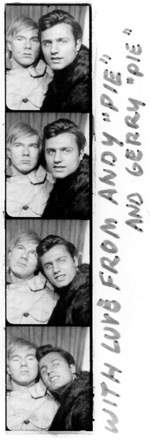Screen Test Superstar
How Gerard Malanga’s poetry defined the early Andy Warhol era.
 Gerard Malanga in Cornwall. Photo © Asako Kitaori
Gerard Malanga in Cornwall. Photo © Asako KitaoriBy the time Gerard Malanga arrived at Andy Warhol’s studio in 1963—accepting a job for $1.25 an hour to help with Warhol’s large-scale silk-screen paintings—the 20-year-old was already an accomplished poet. By his own account, he had been encouraged by poets such as Daisy Aldan and W.H. Auden (the latter told Malanga he was the best American poet under 25 writing today), been “robbed” of a poetry award in a competition at Mount Holyoke College, and was studying with the poet Willard Maas at Wagner College on Staten Island.
Since Malanga had experience working in a screen-printing shop, he decided to make some money on the side at the nascent Factory. Soon, his work evolved from printing and cleaning screens to pulling newspaper images of car crashes and other disasters—the source material for some of Warhol’s best-known paintings of the period—to collaborating with Warhol as he experimented with his new movie camera, a 16-millimeter silent Bolex. As Warhol’s Factory became a social hub as well as the site of production for the artist’s paintings, its focus shifted from paintings to film, and the people who inhabited the studio became the subjects of hundreds of films. Malanga then became a filmmaker. From 1964 to 1966, Warhol and Malanga shot 472 Screen Tests. These were three-minute-long shots, basically, of many people who spent time in Warhol’s now famous silver Factory. The list of subjects reads like a 1960s New York avant-garde Celebrity Register. There were the visual artists (Salvador Dalí, Barbara Rubin, Jack Smith, Paul Thek), the actors and musicians (Bob Dylan, Dennis Hopper, Sally Kirkland, Lou Reed), the Factory regulars and amphetamine heads (Binghamton Birdie, Billy Linich, Ondine, Edie Sedgwick), the intellectuals (Gregory Battcock, Henry Geldzahler, Susan Sontag), the poets (John Ashbery, Ted Berrigan, Allen Ginsberg, John Wieners), and the nobodies (people identified by first names only, such as “Karen,” “Helmut,” or simply “Boy”).
These screen-test stars also became subjects for Malanga’s evolving poetry—by now a far cry from either Auden’s or Maas’s and more like the surreal love lyrics of fellow Factory poet Piero Heliczer. In 1966, Malanga and Warhol began planning their book Screen Tests / A Diary—a book of 54 stills of Screen Tests accompanied by Malanga’s poetry, which was printed in one edition of 500 in 1967. Each Screen Test still shows about two and a half frames of the film, so the reader is aware that these are not photographs but records of moments in time. Malanga’s poems were originally to have been printed on transparent acetate, but when this process proved too complicated the artists opted for a translucent vellum. Had the acetate been used, the imposition of the poems directly over the images of the subjects’ faces would have integrated word and image but would have resulted in considerable obscuration of both the text and the faces. This attests to what was probably the main objective of the—not to present straightforward portraits of each subject, but to create a version of that person that was more subjective, based on a moment in time and the artists’ own personal impression of their friend, colleague, or lover.
 Gerard and Andy in earliest known photobooth portrait, December 1963. Photomaton Series © Gerard Malanga
Gerard and Andy in earliest known photobooth portrait, December 1963. Photomaton Series © Gerard MalangaAfter all, the book was “A Diary,” a personal record of events. Malanga wrote a short poem for every subject included in the book, and each bears a date, which reinforces the idea that the poem captures a particular moment for Malanga. Throughout the book, the poems repeat certain refrains—“Today not much happened” and “What had you been thinking about”—that are directly lifted, from Malanga’s friend Debbie Caen's diary and John Ashbery's poem "The Tennis Court Oath," respectively. The repetition of language mirrors the repetitive format of the Screen Tests, all of which use the same framing, black-and-white film stock, and 100-foot lengths of 16mm film. In Malanga’s poems there are dozens of references to “the friends,” who “never explained why / they take things from other friends” [21, Freddy Herko], who “may / destroy me” [24, “International Velvet”], who “cannot / correct their personal condition / and we’re never on time with each other” [27, Sally Kirkland], who “are hiding from the sunlight / in the small room” [46, Barbara Rubin], who are “forever involved in the ‘family photo’” [29, Billy Linich]. The friends are a group who live outside prescribed structures of mainstream society, amped on amphetamine and jobless, fueled by a desire to move up the Factory food chain as the next superstar, in the orbit of that ultimately nebulous world of fame created by Warhol’s masterful use of publicity.
Malanga was very aware of the power of the photograph, in the mass media and in Warhol’s films and paintings, to fuel gossip and competition among the set of artists and hangers-on that made up Warhol’s Factory crowd in the mid-1960s. Malanga’s own interests were still in some ways inextricably bound up in Warhol’s, in that he was then more well known as Warhol’s beautiful assistant and male superstar/whip dancer than he was as a poet. His fame was cemented in this way because of the dissemination of his image in the Village Voice and Vinyl (among other places) and in Warhol’s films. But as his poetry from this time reflects, Malanga was also the sentimental scribe of the Factory. The poems that accompany the Screen Test stills impart a particular feeling of intimacy to the spectrum of faces—after all, the photo for which the friends pose is a “family photo,” not a publicity shot. Malanga, who shrewdly maintained curatorial control over whose images were to be included in the final book (he has said that if he was not inspired by the subjects, he could not write a poem about them and therefore they could not appear in the book, even though Warhol tried to have friends such as Henry Geldzahler and Ultra Violet included), creates a constellation personal to Malanga’s own world of love and friendship, and all the nuances that those relationships entail—which for this particular time happened to be rather contentious but also highly creative and productive.
This essay is dedicated to the memory of Callie Angell, a phenomenal scholar and dear friend.


